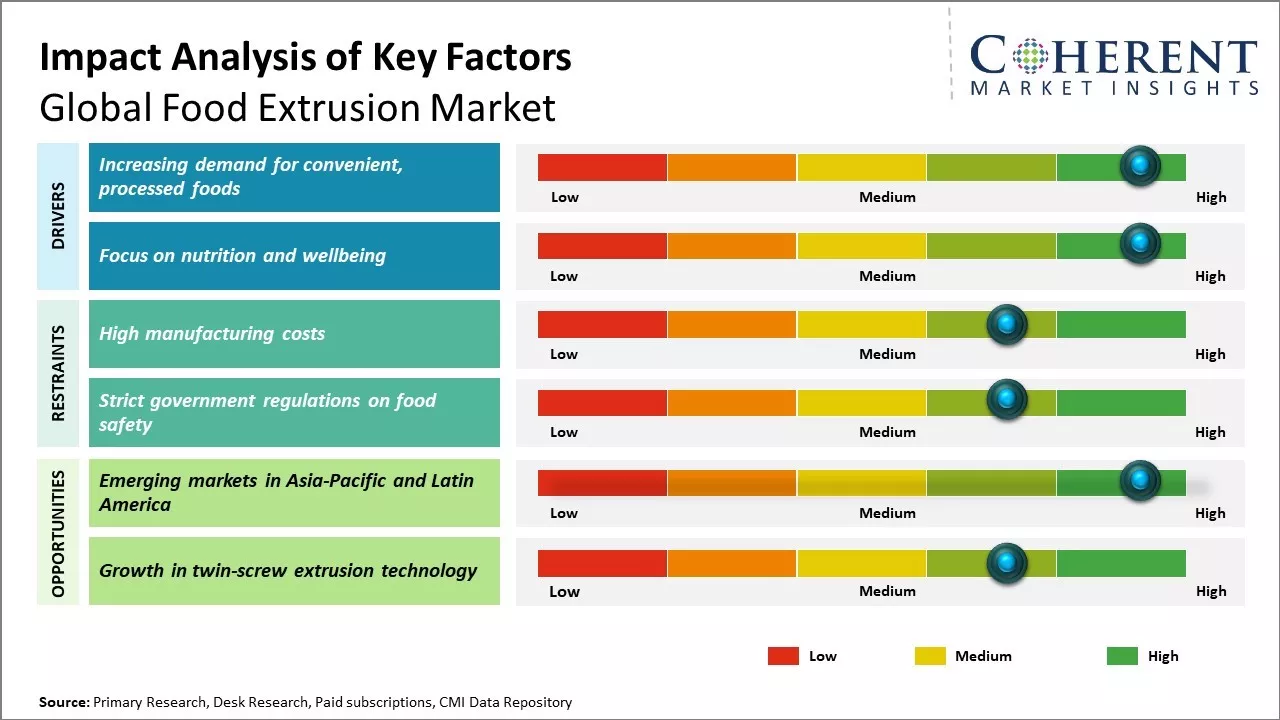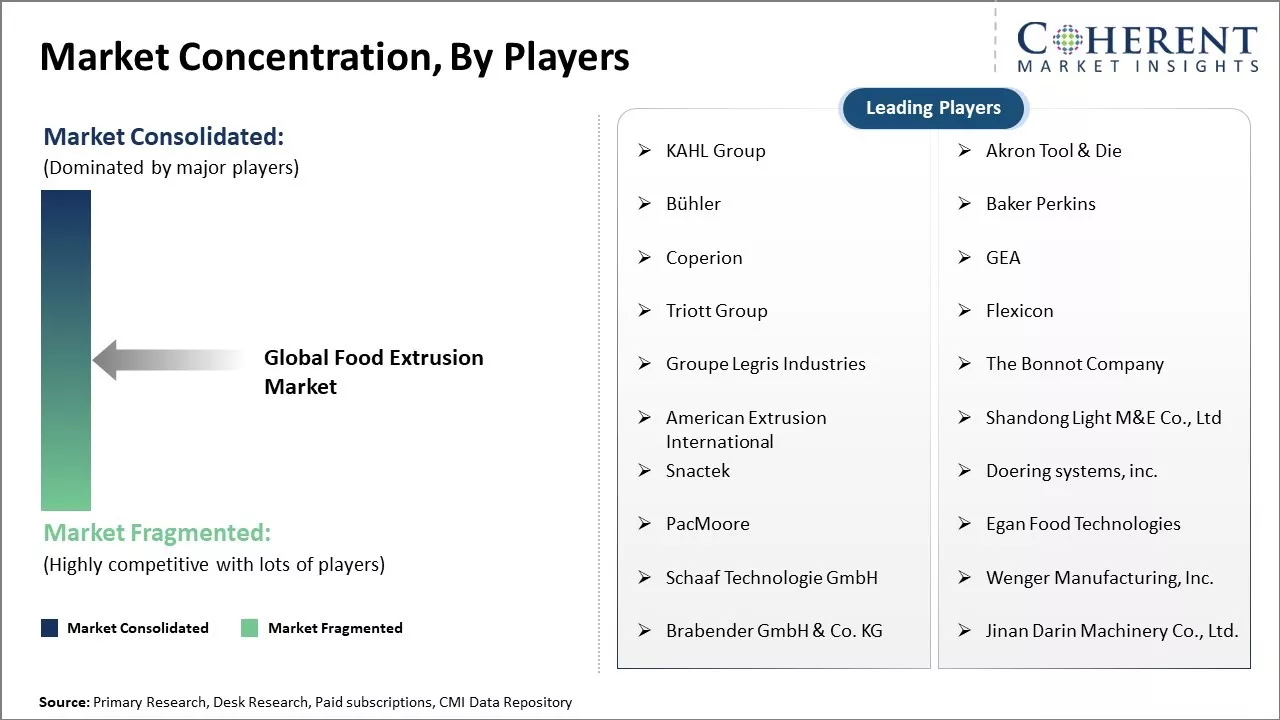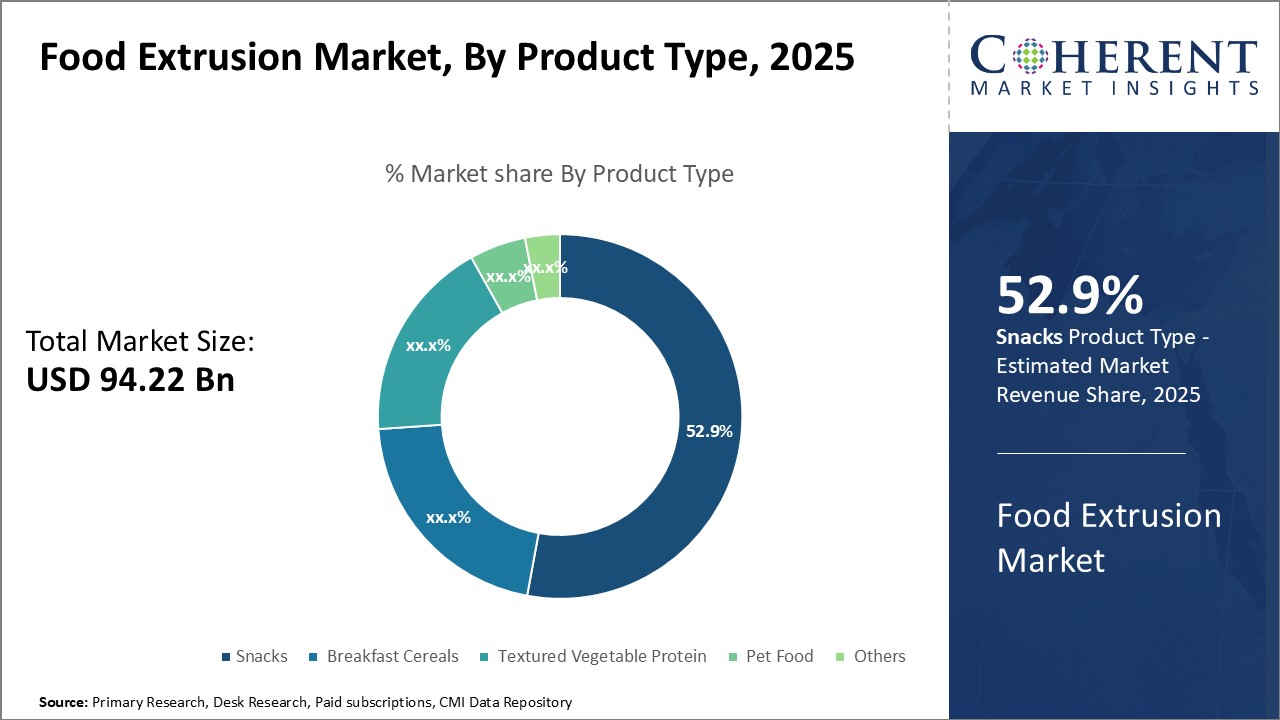Food Extrusion Market Size and Trends
The Food Extrusion Market is estimated to be valued at USD 94.22 Bn in 2025 and is expected to reach USD 148.46 Bn by 2032, exhibiting a compound annual growth rate (CAGR) of 6.7% from 2025 to 2032.

Discover market dynamics shaping the industry: Download Free Sample
Extruded food products offer significant advantages over other processing methods as they can be produced in a single, continuous process and also lead to improved texture and nutritional profile of finished products. Additionally, growing demand for convenience and ready-to-eat snacks and foods is further expected to drive the market growth. Improving economic conditions and rising disposable incomes in developing countries will also contribute to the market growth as consumers spend more on packaged and processed food products. However, stringent regulations regarding food safety and quality may hamper the growth to some extent over the forecast period.
Increasing demand for convenient, processed foods
The fast-paced, hectic lifestyle that many people around the world seem to adopt has significantly boosted demand for convenient, processed foods that save on time spent in the kitchen. Extruded food products like ready-to-eat cereals, savory snacks and breakfast bars have become extremely popular as they can be easily prepared and consumed on the go. Busy consumers appreciate how extruded items do not require much preparation work and can be eaten anywhere without the need for cooking utensils or appliances. This direct appeal of extruded foods to harried urban populations has encouraged food companies to expand their portfolios of convenient snack options. Furthermore, the growth of nuclear families where both parents work means greater demand for time-saving, kid-friendly breakfast and snack ideas. Extrusion being a high-volume production technology allows the mass manufacturing of convenient fiber-fortified cereal bars, puffed snacks, etc., offering affordable options to time-starved households. Rising health awareness about balanced nutrition has also prompted the development of extruded snacks containing whole grains, proteins, and fiber. The convenience and perceived wellness factors together are major contributors to the increasing preference for extruded packaged foods.
Market Concentration and Competitive Landscape

Get actionable strategies to beat competition: Download Free Sample
Focus on nutrition and wellbeing
In recent years, consumers across the world seem to be paying greater attention to the link between diet and overall health and wellbeing. This has upped the demand for wholesome, nutritious foods that provide functional benefits beyond basic sustenance. The extrusion process enables fortifying staple grains with essential micronutrients to address nutritional deficiencies. It also aids producing foods that are enriched with proteins, fibers, prebiotics and omega-3 fatty acids known to promote health. Manufacturers are actively developing extruded products focused on specific health aspects like cognitive function, gut health, heart health, etc. For example, fiber-rich multi-grain cereals for regularity and weight management, protein-enriched snacks for muscle recovery. Even savory snacks are incorporating vegetables, legumes, and ancient grains through extrusion. The growing wellness-oriented consumer base is gravitating towards extruded options perceived as naturally nutritive. Additionally, individuals with food allergies and lifestyle-based diets like veganism and paleo are driving diversification in specialized extruded foods suitable for their requirements.
Key Takeaways from Analyst:
The food extrusion market growth is driven by the rising demand for processed and ready-to-eat food products across the world. Extrusion technology provides opportunities to manufacturers to mass-produce food efficiently and cost-effectively. Snacks and breakfast cereals are dominating the application segment currently due to increased consumption of convenient on-the-go food items. However, with rising health-consciousness, flourishing pet food industry may emerge as the fastest growing application segment.
North America currently dominates the regional market landscape but Asia Pacific is expected to surpass all other regions during the forecast period supported by the expanding food processing sector in major countries like India and China. High initial investment required for extrusion equipment and continuous cost of maintenance can pose challenges for new entrants in the market. Changing consumer preference towards natural and clean label ingredients may limit usage of modified starches and other additives in extruded food over time.
Intensifying competitive pressure among manufacturers prompts bolstering investment in product development and customization. Demographic shifts towards nuclear families with dual working parents keep demand for ready meals robust. Rapid urbanization also accelerates the trend as nuclear families opt for convenient packaged food options.
Market Challenges: High manufacturing costs
The high manufacturing costs associated with food extrusion equipment and processes is negatively impacting the growth of the food extrusion market. Food extrusion involves complex machinery that utilizes heat and pressure to shape, mix, homogenize, and texturize ingredients. This equipment requires a significant capital expenditure that not all food manufacturers can afford. Additionally, operating costs are also high due to energy-intensive motors that power the extruders as well as high maintenance costs to keep the machinery running optimally.
Market Opportunities: Emerging markets in Asia-Pacific and Latin America
The food extrusion market in emerging economies of Asia-Pacific and Latin America regions holds great potential for growth over the coming years. These regions have seen rising disposable incomes and growth of middle-class populations in countries like India, Indonesia, Brazil, and Mexico. This has significantly increased the demand for packaged, convenient, and processed foods. Food extrusion offers an efficient way of producing snacks, breakfast cereals, and other processed food products at scale to meet the needs of large populations in these regions. Several international and domestic food companies have already established manufacturing bases in countries like India and Brazil to cater to the rapidly growing domestic demand.

Discover high revenue pocket segments and roadmap to it: Download Free Sample
Insights by product type : Consumers’ Expanding Snacking Habits Drive Snacks Demand
In terms of Product Type, the Snacks segment is estimated to hold 52.9% share of the market in 2025, owing to consumers' expanding snacking habits. Today's consumers are increasingly choosing snacks over regular meals as snacking allows for flexibility. The fast-paced lives that most people lead means they often need easier and quicker food options. Snacks satisfy hunger pangs without compromising on taste or convenience. Working professionals and students in particular rely heavily on snacks to fulfill their daily nutrition requirements in between meals.
Snacks have evolved greatly from just being crisps and chips. Currently available are extruded snacks in various formats like shapes, blends and flavors that offer varieties to choose from. This wide range of snacking options provides consumers enjoyment and satisfies different moods or cravings. Popular snacks being extruded include corn snacks, multi-grain chips, and nutrient enriched bars. Functional snacks containing ingredients like protein, fiber and prebiotics also have growing demand. Their health credentials make snacks justifiable indulge options versus traditional sweets or bakery items.
Another factor propelling the snack segment is aggressive marketing by manufacturers. Constant innovation in flavors, packaging designs, and attractive deals incentivize trials and repurchases. Social media promotion strategies too help create buzz and engage target audiences. Overall, changing lifestyles, busier routines and well-stocked retail shelves ensure snacks remain consumers' favorite quick meals. This sustained snack demand is a major driver for the food extrusion market currently.
Insights by Equipment Type : Utilization of Mechanization and Automation Spurs Twin Screw Extruders Demand
In terms of Equipment Type, the Twin Screw Extruders segment is estimated to hold 40.7% share in 2025, owing to their utilization of mechanization and automation. Manufacturers extensively rely on extrusion systems to mass-produce snack and pet food products for worldwide distribution. Here, twin screw extruders have gained prominence over single screw models due to higher output capabilities.
Twin screw extruders contain two closely spaced rotating screws inside the barrel that work together to efficiently mix, knead and pump materials. Their intermeshing screw profile self-regsulate material flow with minimal pressure buildup. This self-wiping action produces uniform mixes without adhesion or scorching risks compared to single screw variants. Twin screws also allow for longer residence times that ensure homogeneous blending even with complex formulations.
Additionally, advanced twin screw extruders now incorporate automated feeding systems, conditioning modules and die design options. Real-time process monitoring and easy recipe changes minimize downtimes. Such extensive mechanization reduces labor requirements. Therefore, with high throughputs and less human intervention needed, twin screw extruders offer optimal productivity at mass scales sought by large producers. Their consistent performance across production cycles delivers quality standardized end-products too. Overall emphasis on automation and energy-efficiency will augment twin screw extruder uptake in future.
Insights by End-Use Industry : Expanding Processed Food Culture Boosts Food & Beverage Demand
In terms of End-Use Industry, the Food and Beverage segment is estimated to hold 34% share to the market in 2025, owing to expanding processed food culture. Urbanization, rising living standards and nuclear family structures have transformed consumer diets over the past decade. Ready-to-eat convenience foods now dominate grocery shelves meeting people's fast lifestyles. This has upscaled demand for extruded snack varieties among food companies.
Extrusion technology helps manufacturers develop affordable, nutritious snack options across categories like potato, corn and multigrain. Their long shelf-life favors hypermarket distribution too. Beverage firms also extrude cereals for breakfast food/drink sachets targeting time-starved customers. As health awareness rises, extrusion allows fortifying products with vitamins, minerals and fibers in consistent formats.
Changing food preferences and expanding working women population as well mean more sales from extruded household pet food. Pet owners attribute nutrition, texture, and digestibility benefits to extruded kibble versus traditional recipes. These applications cement food and beverage industry utilization of extrusion processing. Sustained urban consumerism will push further new product extrusion trials catering to modern diets and living. Formulating popular local cuisine variants using extrusion could open lucrative markets.
Regional Insights

Need a Different Region or Segment? Download Free Sample
The North American region has dominated the global food extrusion market for many years with an estimated 35.0% share in 2025. Being one of the largest consumers of snacking foods worldwide, the region sees huge demand for extruded snack products like ready-to-eat cereals, breakfast cereals, savory snacks, and snacks bars. Major food corporations headquartered in the U.S. and Canada have established themselves as leading players in the global extruded food industry by catering to the region's taste preferences through continuous product innovations. Furthermore, the presence of advanced extrusion technologies and strong technical expertise among equipment manufacturers in North America provide a competitive advantage to processors. The cost-effective domestic sourcing and logistics also support manufacturing activities in the region.
The Asia Pacific market, especially countries like China, India, and Southeast Asia, is emerging as the fastest-growing regional market for food extrusion. Rapid urbanization, rising disposable incomes, and changing lifestyles and food consumption patterns in these developing nations are fueling the demand for convenient packaged foods. Extruded snacks, baked goods, and ready meals are gaining popularity as healthy on-the-go meal options. Local processors are actively collaborating with international food corporations to adopt extrusion technologies for producing both western and traditional Asian snack varieties. Countries like India have also implemented initiatives to promote domestic agro-industries through food processing, thereby spurring opportunities for extrusion equipment suppliers. Strong economic growth, a booming young population, and growing health-consciousness in Asia are expected to continue propelling the extruded food industry growth across the region.
Market Report Scope
Food Extrusion Market Report Coverage
| Report Coverage | Details | ||
|---|---|---|---|
| Base Year: | 2024 | Market Size in 2025: | USD 94.22 Bn |
| Historical Data for: | 2020 To 2024 | Forecast Period: | 2025 To 2032 |
| Forecast Period 2025 to 2032 CAGR: | 6.7% | 2032 Value Projection: | USD 148.46 Bn |
| Geographies covered: |
|
||
| Segments covered: |
|
||
| Companies covered: |
KAHL Group, Akron Tool & Die, Bühler, Baker Perkins, Coperion, GEA, Triott Group, Flexicon, Groupe Legris Industries, The Bonnot Company, American Extrusion International, Shandong Light M&E Co., Ltd, Snactek, Doering systems, inc., PacMoore, Egan Food Technologies, Schaaf Technologie GmbH, Wenger Manufacturing, Inc., Brabender GmbH & Co. KG, and Jinan Darin Machinery Co., Ltd. |
||
| Growth Drivers: |
|
||
| Restraints & Challenges: |
|
||
Uncover macros and micros vetted on 75+ parameters: Get instant access to report
Food Extrusion Industry News
- In April 2024, Givaudan, in collaboration with MISTA and Bühler, announced the launch of a cutting-edge extrusion hub at the MISTA Innovation Center in San Francisco. This strategic partnership aims to enhance innovation in the food industry, particularly in the realm of extrusion technology, which is pivotal for developing a variety of food products.
- In 2021, Flexicon Corporation Pty Ltd made a significant strategic move by doubling the size of its manufacturing and sales operations. This expansion is poised to enhance the company’s growth trajectory, particularly in the Asian market, which is known for its dynamic economic environment and increasing demand for innovative solutions.
- In 2021, Givaudan and Bühler launched the APAC Protein Innovation Centre at Givaudan's Woodlands site in Singapore. This collaborative initiative aims to drive innovation in plant-based product development, leveraging the expertise and resources of both companies.
*Definition: The Food Extrusion Market involves production of food products through an extrusion process. Extrusion cooking is used to make a variety of food items like snacks, cereals, pet food, and textured food products. It is a high-temperature short-time process that uses a combination of heat, shear force, and pressure to cook ingredients into a form that can be molded or shaped into the final product. The global Food Extrusion Market has seen significant growth in recent years with rising demand for nutritional and convenient snack options.
Market Segmentation
- Product Type Insights (Revenue, USD Bn, 2020 - 2032)
- Snacks
- Breakfast Cereals
- Textured Vegetable Protein (TVP)
- Pet Food
- Others
- Equipment Type Insights (Revenue, USD Bn, 2020 - 2032)
- Single Screw Extruders
- Twin Screw Extruders
- Co-rotating Twin Screw Extruders
- Counter-rotating Twin Screw Extruders
- Others
- End-use Industry Insights (Revenue, USD Bn, 2020 - 2032)
- Food and Beverage
- Others
- Regional Insights (Revenue, USD Bn, 2020 - 2032)
- North America
- U.S.
- Canada
- Latin America
- Brazil
- Argentina
- Mexico
- Rest of Latin America
- Europe
- Germany
- U.K.
- Spain
- France
- Italy
- Russia
- Rest of Europe
- Asia Pacific
- China
- India
- Japan
- Australia
- South Korea
- ASEAN
- Rest of Asia Pacific
- Middle East & Africa
- GCC Countries
- Israel
- Rest of Middle East & Africa
- North America
- Key Players Insights
- KAHL Group
- Akron Tool & Die
- Bühler
- Baker Perkins
- Coperion
- GEA
- Triott Group
- Flexicon
- Groupe Legris Industries
- The Bonnot Company
- American Extrusion International
- Shandong Light M&E Co., Ltd
- Snactek
- Doering systems, inc.
- PacMoore
- Egan Food Technologies
- Schaaf Technologie GmbH
- Wenger Manufacturing, Inc.
- Brabender GmbH & Co. KG
- Jinan Darin Machinery Co., Ltd.
Share
Share
About Author
Yash Doshi is a Senior Management Consultant. He has 12+ years of experience in conducting research and handling consulting projects across verticals in APAC, EMEA, and the Americas.
He brings strong acumen in helping chemical companies navigate complex challenges and identify growth opportunities. He has deep expertise across the chemicals value chain, including commodity, specialty and fine chemicals, plastics and polymers, and petrochemicals. Yash is a sought-after speaker at industry conferences and contributes to various publications on topics related commodity, specialty and fine chemicals, plastics and polymers, and petrochemicals.
Missing comfort of reading report in your local language? Find your preferred language :
Transform your Strategy with Exclusive Trending Reports :
Frequently Asked Questions
EXISTING CLIENTELE
Joining thousands of companies around the world committed to making the Excellent Business Solutions.
View All Our Clients
